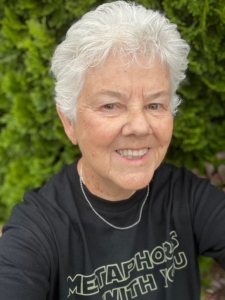Trees as Muse
by Irene Honeycutt
Needing to feel grounded, I sit outside, an acorn in my hand. A slight breeze brushes my face. I loosen my grip on the acorn; and it feels lighter, as if it might mysteriously dissolve and flow into my veins.
Does this acorn hold within its DNA the tiny thing the size of a hazelnut that Julian of Norwich held in her palm? Julian writes that she “looked at this with the eye of my soul and thought: ‘What can this be?’” Such a small thing! Denise Levertov would later address Julian in one of her dialogues: “…you ask us to turn our gaze/inside out, and see a little thing,/the size of a hazelnut,/and believe it is our world?” And in her “Notes on Organic Form,” Levertov seals her own belief by seeing the act of writing as a communion of everything (no small thing): “…writing is not a matter of one element supervising the others but of intuitive interaction between all the elements involved.” The genesis, then, of the written work of art emanates from paying attention to the world. O Taste and See, Levertov implores. This requires the deep gaze, not the passing glance.
*****
How far we have come in recognizing the interconnectedness of all things (beings). Still, mystery remains. “On the last day of the world I would want to plant a tree,” W. S. Merwin writes. And Mary Oliver has said that she could almost say trees saved her. Poems guide, rage, console, inspire, bear witness. Can we say the same of trees?
One recent morning, I opened the back door, expecting the usual heat wave. My dog, as surprised as I by the brisk air, began running laps round and round the backyard and I quickly went and stood close to my evergreen tree. I parted a few of the branches and peeked inside. Some gift was always there. As with the giving tree in To Kill a Mockingbird. This time a silky hammock spun overnight held the morning’s catch: a few drops of dew and a sparkle of sunlight and a little something for the spider. I let the branches close on this secret space. And thought of Suzanne Simard’s Finding the Mother Tree which I’d been reading the night before, stunned by the brilliance of her style in conveying the complicated scientific results of her studies of how trees develop elaborate systems of communication. Understories. Interwoven among the trees are branches of her personal journey with cancer. In the forests, she confronts fear; finds joy and courage. Her memoir reminds me of how poets and fiction writers convey similar themes. In one of my favorite short stories taught by a beloved teacher when I was a college sophomore, E. B. White’s character notices “the second tree from the corner” and comes to an epiphany.
Go find your tree. Write about it.
Trees as Muse in Print
Here’s an example of a writer using trees as muse: “In The Petrified Forest” by Dan Musgrave. You can submit your own nonfiction to Outpost19’s tree-tethered nonfiction anthology, Rooted, here.
Irene Blair Honeycutt is an award-winning teacher and poet. Her fourth poetry book, Beneath the Bamboo Sky (Main Street Rag, 2017), is sub-titled Poems and Pieces on Loss and Consolation. Irene’s kinship with trees began in her childhood in Florida where she built and retreated to her palm hut. She still meets with the woods and enjoys writing time in her mountain cabin. Her work has been published by journals, including Nimrod, Southern Poetry Review, The Southern Poetry Anthology: VII, Black Moon Magazine, Kakalak and Virginia Quarterly. She founded Central Piedmont Community College’s Sensoria, mentors writers, and is completing her fifth poetry manuscript.
Learn From Irene: The tree as nurturer, witness, listener—a source of terror, even—has drawn poets through the ages to reflect on its Mystery. In the first of our two meetings, we’ll explore a variety of “tree” writings and discuss how these pieces reflect our humanness. Then, through a visualization writing prompt that takes us deeper into our relationship with them, we’ll invoke trees as muses to inspire our intuitive writing processes. During our second meeting, participants will be encouraged (not pressured) to share short writings inspired by the prompt.
Learn more and register here.

